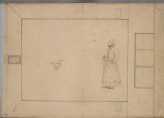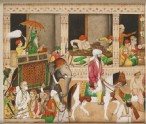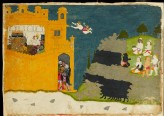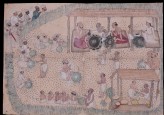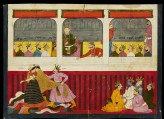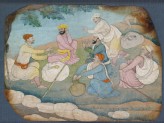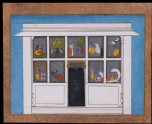Visions of Mughal India: The Collection of Howard Hodgkin
(from 2nd Feb until 22nd Apr 2012)Explore the remarkable collection of Indian paintings and drawings of the artist Howard Hodgkin.
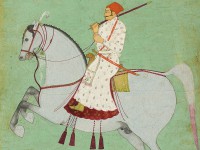
- This is a visual browsing tool that maps objects in this publication, gallery or collection trail by date of creation onto a timeline.
- The circular markers indicate where objects are on the timeline.
- The size of the markers indicates the relative number of objects at that point on the timeline.
- Hover over a marker to find out which objects are represented at that point in time.
- To expand, collapse or hide the timeline, click these symbols
 found at the top right of the timeline.
found at the top right of the timeline.
- 1580
- 1600
- 1620
- 1640
- 1660
- 1680
- 1700
- 1720
- 1740
- 1760
- 1780
- 1800
- 1820
- 1840
- 1860
- 1880
At the semi-independent Pahari (‘Hill’) courts in the Punjab Hills in the north-west, the local Hindu Rajput rulers traditionally favoured vivid and robust styles of manuscript illustration. These works of the late 17th and 18th centuries include exceptionally powerful images of the deities Bhadrakali and Harihara Sadashiva (LI118.82, LI118.4), and portraits of Basohli rulers (LI118.37, LI118.38, LI118.90) which transform the sober Mughal convention of the ruler quietly smoking his hookah. With their shifting scale and boldness of line, colour and pattern, they create an atmosphere more intense than serene. Another important genre was Ragamala (‘Garland of Ragas’), series of illustrations depicting the essential spirit of the ragas or musical modes, which were grouped into families with their ‘wives’ (ragini) and ‘sons’ (ragaputra). Pahari Ragamala pictures are small, square and compactly composed, usually with two or more figures of men, women, animals, gods or yogis, engaged in decorous yet highly charged encounters. They are sometimes devotional or heroic, but more often erotic in mood.
By the early 17th century, the Pahari rulers – like their peers from the Rajput courts of Rajasthan – were increasingly required to attend the imperial court, where they were exposed to Mughal tastes in painting and other arts. One of the earliest paintings attributable to any Pahari court, the Marriage procession in a bazaar (LI118.28), is very much in the contemporary Mughal style.
In the 18th century, the resurgence of imperial painting under the emperor Muhammad Shah (r.1719-1748) brought a renewed access of Mughal technique to the Hills, disseminated by travelling artists of the Guler school, including the highly gifted Nainsukh. Howard Hodgkin has in recent years acquired important works by this great Pahari artist, depicting his patron Balwant Singh hunting a tiger and encountering a goose (LI118.109, LI118.108).
Deities and ragas
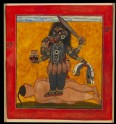 Bhadrakali, Destroyer of the Universe (LI118.82)
Bhadrakali, Destroyer of the Universe (LI118.82)
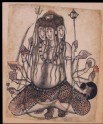 Harihara Sadashiva (LI118.4)
Harihara Sadashiva (LI118.4)
 Brahma, Creator of the Universe (LI118.6)
Brahma, Creator of the Universe (LI118.6)
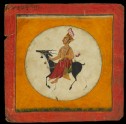 The moon god, illustrating the musical mode Raga Chandra (LI118.84)
The moon god, illustrating the musical mode Raga Chandra (LI118.84)
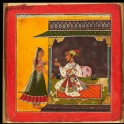 A prince and lady meeting, illustrating the musical mode Raga Madhava (LI118.83)
A prince and lady meeting, illustrating the musical mode Raga Madhava (LI118.83)
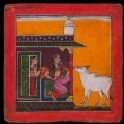 A lady and a bull, illustrating the musical mode Bhairavi Ragini (LI118.86)
A lady and a bull, illustrating the musical mode Bhairavi Ragini (LI118.86)
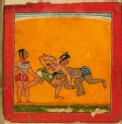 Wrestlers, illustrating the musical mode Raga Malava (LI118.85)
Wrestlers, illustrating the musical mode Raga Malava (LI118.85)
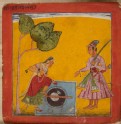 A lady and prince at a well, illustrating the musical mode Raga Kumbha (LI118.114)
A lady and prince at a well, illustrating the musical mode Raga Kumbha (LI118.114)
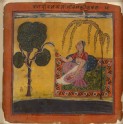 A lady offers milk to a snake, illustrating the musical mode Ramakali Ragini (LI118.105)
A lady offers milk to a snake, illustrating the musical mode Ramakali Ragini (LI118.105)
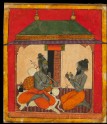 Ascetics making music, illustrating the musical mode Kedara Raga (LI118.87)
Ascetics making music, illustrating the musical mode Kedara Raga (LI118.87)
 A prince and a lady, illustrating the musical mode Kusuma Raga (LI118.104)
A prince and a lady, illustrating the musical mode Kusuma Raga (LI118.104)
Royal portraiture
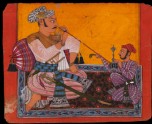 Maharaja Bhupat Pal smoking a hookah (LI118.38)
Maharaja Bhupat Pal smoking a hookah (LI118.38)
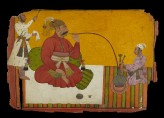 Maharaja Kirpal Pal of Basohli smoking a hookah (LI118.37)
Maharaja Kirpal Pal of Basohli smoking a hookah (LI118.37)
 Maharaja Medini Pal smoking a hookah (LI118.90)
Maharaja Medini Pal smoking a hookah (LI118.90)
Court life, urban life, and mythological scenes
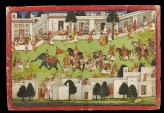 Marriage procession in a bazaar (LI118.28)
Marriage procession in a bazaar (LI118.28)
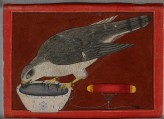 A goshawk drinking (LI118.106)
A goshawk drinking (LI118.106)
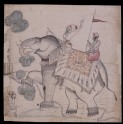 Elephant eating a tree (LI118.59)
Elephant eating a tree (LI118.59)
Notice
Objects from past exhibitions may have now returned to our stores or a lender. Click into an individual object record to confirm whether or not an object is currently on display. Our object location data is usually updated on a monthly basis, so please contact the Jameel Study Centre if you are planning to visit the museum to see a particular Eastern Art object.
© 2013 University of Oxford - Ashmolean Museum


